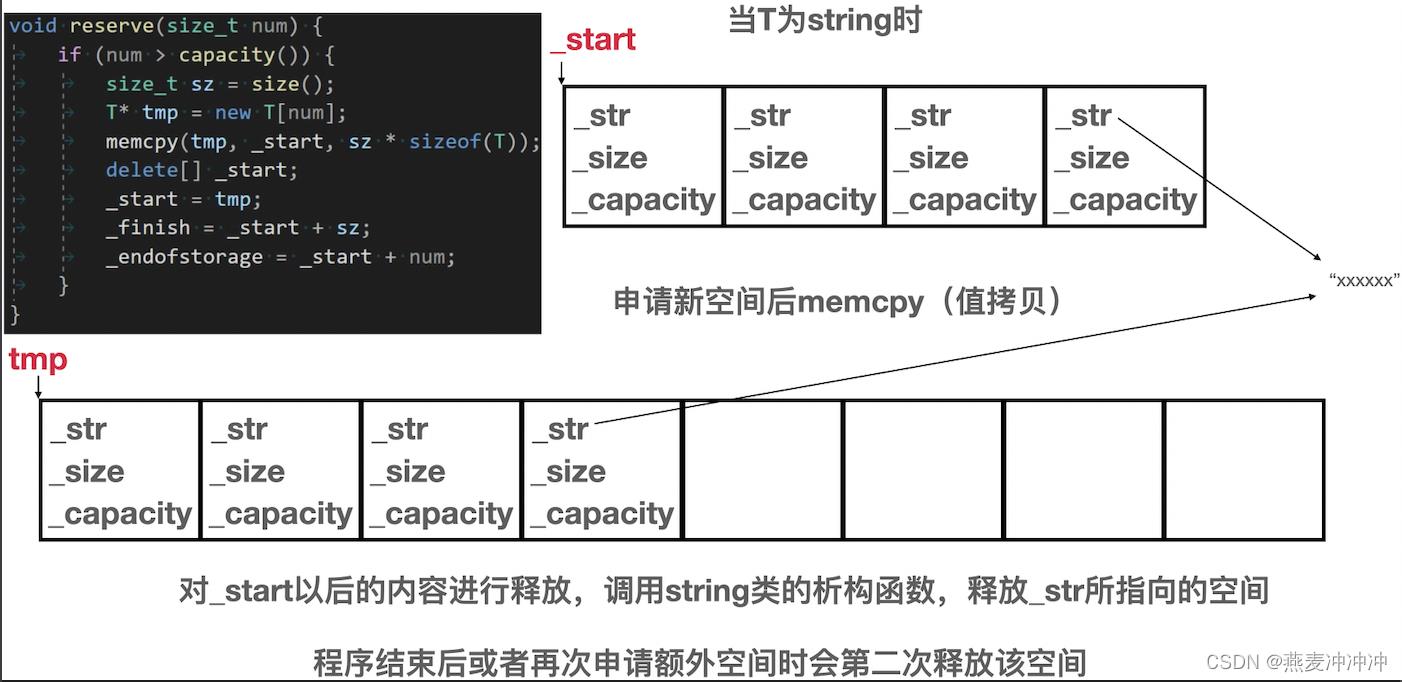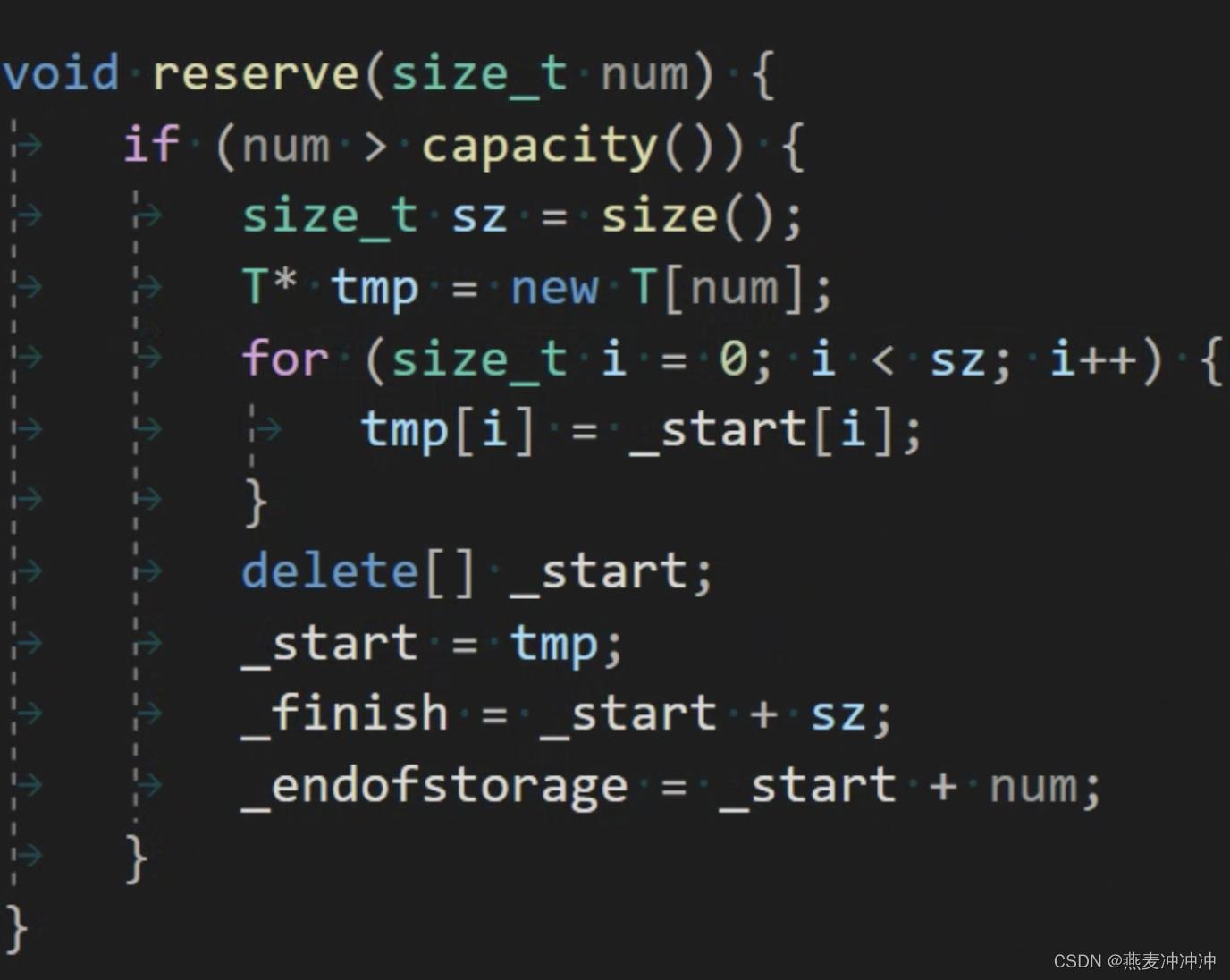C++ vector基本使用与模拟实现
Posted 燕麦冲冲冲
tags:
篇首语:本文由小常识网(cha138.com)小编为大家整理,主要介绍了C++ vector基本使用与模拟实现相关的知识,希望对你有一定的参考价值。
vector的使用与模拟实现
一、基本接口的调用
#include<iostream>
#include<vector>
#include<string>
#include<stdio.h>
#include<algorithm>
using namespace std;
void test_vector1()
vector<int> v;
v.push_back(1);
v.push_back(2);
v.push_back(3);
v.push_back(4);
v.push_back(5);
//遍历vector的几种方式
for (size_t i = 0; i < v.size(); i++) //1、下标+[]
cout << v[i] << " ";
cout << endl;
vector<int>::iterator it = v.begin(); //2、迭代器
while (it != v.end())
cout << *it << " ";
it++;
cout << endl;
for (auto e : v) //范围for
cout << e << " ";
cout << endl;
vector<int>::reverse_iterator rit = v.rbegin();
while (rit != v.rend())
cout << *rit << " ";
rit++;
cout << endl;
vector<int> v2(++v.begin(), --v.end()); //利用迭代器区间构造对象————区间左闭右开
string s("hello world");
vector<char> v3(s.begin(), s.end()); //其它容器的迭代器只要类型匹配同样适用
vector<int> v4;
v4.assign(s.begin(), s.end()); //assign接口类似————中文意思为分配
void test_vector2()
vector<int> v;
v.reserve(10);//开空间改变容量,但不初始化
//错误访问——————下标引用操作符会检查插入位置是否合法,即小于_size
//for (size_t i = 0; i < 10; i++)
//
// v[i] = i;
//
//正确访问
for (size_t i = 0; i < 10; i++)
v.push_back(i);
v.resize(20);//开空间+初始化
void test_vector3()
int a[] = 1,2,3,4,5 ;
vector<int> v(a, a + 5);
//头插
v.insert(v.begin(), 0); //第一个参数传入的是迭代器
//在2前面插入
vector<int>::iterator pos = find(v.begin(), v.end(), 2); //find函数位于算法库中algorithm
if (pos != v.end()) //查找失败会返回end位置的迭代器
v.insert(pos, 20);
//sort排序
sort(v.begin(), v.end());
sort(v.begin(), v.end(), greater<int>()); //greater<int>是一个仿函数类,需要调用库函数是functional
void test_vector4()
int a[] = 1,2,3,4,5 ;
vector<int> v(a, a + 5);
//头删
v.erase(v.begin()); //参数传入下标位置的迭代器,或迭代器区间
//删除2
vector<int>::iterator pos = find(v.begin(), v.end(), 2);
if (pos != v.end())
v.erase(pos);
int main()
test_vector1();
test_vector2();
test_vector3();
test_vector4();
return 0;
vector的重要知识点再回顾
迭代器因insert失效(erase同理)
结论:在insert(pos, x)以后,都认为pos迭代器失效了,不要再去使用pos了。
原因:1、插入可能导致扩容,而异地扩容会导致pos变成“野指针”。
2、就算不扩容,pos指向的位置意义已经变化了,所以也认为失效。
解决方案:insert的返回值是指向新插入元素的迭代器位置。利用返回值赋值给pos即可。
模拟实现vector
template<class T>
class vector
public:
typedef T* iterator;
typedef const T* const_iterator;
vector()
:_start(nullptr)
,_finish(nullptr)
,_endofstorage(nullptr)
vector(const vector<T>& v)
:_start(nullptr)
, _finish(nullptr)
, _endofstorage(nullptr)
reserve(v.capacity());
for (const auto e : v)
push_back(e);
template <class InputIterator>
vector(InputIterator first, InputIterator last)
:_start(nullptr)
, _finish(nullptr)
, _endofstorage(nullptr)
while (first != last)
push_back(*first);
first++;
~vector()
delete[] _start;
_start = _finish = _endofstorage = nullptr;
iterator begin()
return _start;
iterator end()
return _finish;
const_iterator begin()const
return _start;
const_iterator end()const
return _finish;
size_t capacity() const
return _endofstorage - _start;
size_t size() const
return _finish - _start;
void reserve(size_t num)
if (num > capacity())
size_t sz = size();
T* tmp = new T[num];
memcpy(tmp, _start, sz * sizeof(T));
_start = tmp;
_finish = _start + sz;
_endofstorage = _start + num;
iterator insert(iterator pos, const T& num)
assert(pos >= begin() && pos <= end());
if (_finish == _endofstorage)
size_t len = pos - _start;
size_t newcapacity = capacity() == 0 ? 4 : capacity() * 2;
reserve(newcapacity);
pos = _start + len;
iterator end = _finish - 1;
while (end >= pos)
*(end + 1) = *end;
end--;
*pos = num;
_finish++;
return pos;
iterator erase(iterator pos)
assert(pos >= begin() && pos < end());
//删除指定下标的数据,并把其后的数据依次向前挪动
iterator it = pos + 1;
while (it != end())
*(it - 1) = *it;
it++;
--_finish;
return pos;
void push_back(const T& num)
insert(end(), num);
T& operator[](size_t i)
assert(i < size());
return *(_start + i);
void swap(vector<T>& v)
std::swap(v._start, _start);
std::swap(v._finish, _finish);
std::swap(v._endofstorage, _endofstorage);
vector<T>& operator=(vector<T> v)
swap(v);
return *this;
void resize(size_t n, const T& val = T())
//开的空间小于size(把超出范围的舍弃)介于size和capacity(初始化_finish以后的空间)
//大于capacity(要重新开空间,并且初始化_finish以后的空间)
if (n <= size())
_finish = _start + n;
else
if (n > capacity())
reserve(n);
while (_finish < _start + n)
*_finish = val;
_finish++;
private:
iterator _start;
iterator _finish;
iterator _endofstorage;
;
vector模拟实现中reserve的bug
更深层次的浅拷贝引发的问题

解决方案:利用string类重载的=实现深拷贝

以上是关于C++ vector基本使用与模拟实现的主要内容,如果未能解决你的问题,请参考以下文章